





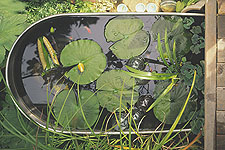 This easy project is an attractive addition to any yard.
This easy project is an attractive addition to any yard.
This pond takes only a few hours to make -- and it can be made out of nearly anything that holds water.
Oak barrels, old sinks, or bathtubs all can make fine backyard ponds. This particular model is made from a stainless steel sitz bath. It's so easy to assemble that you can gather your supplies on Saturday morning, fill the pond with water in the afternoon, and launch the fish into their home after waiting 48 hours for the chlorine to disperse.
Want to add even more water features? Try a tabletop fountain.
Like a natural pond, this one depends on a delicate balance of plants, snails, tadpoles, and fish rather than on pumps and filters to keep the water fresh. It includes oxygenating grasses (which add oxygen to the water) and floating plants such as water hyacinths (which provide hiding space among their roots for pond creatures). This menagerie includes tadpoles and goldfish.
When winter comes, plants sit underwater on the bottom of the pond; fish and tadpoles winter inside.
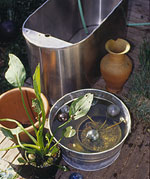 Gather your supplies.
Gather your supplies.
1. If you use an oak barrel: Line it with polyvinyl chloride (PVC) flexible liner in 20 mil thickness to keep chemicals from leaching into the water.
2. Consider your site. Look for a spot that offers at least 4 hours of sun each day. Morning sun is kinder to water plants than late-day sun.
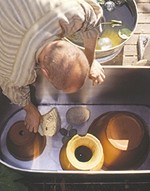 Step 3
Step 3
3. Lay out your plan. Place a variety of objects on the bottom of the pond. Some, such as inverted pots, serve as planting ledges for potted water plants. Other pieces of stone and terra-cotta provide interesting objects to spy through the water as well as places for tadpoles and fish to hide. Fill the pond with water and treat with dechlorinator, according to package directions.
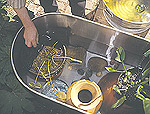 Step 4
Step 4
4. Add flora. Your water-garden supplier can make suggestions about how many plants and animals you need to support the size of your pond. Consider oxygenating grasses, water lilies, hornwort, and water hyacinths. Plant one bunch of oxygenating grasses per 2 square feet of pond surface; these grasses grow in containers sitting on the pond bottom. The water hyacinths float on the surface. The other plants are potted in pea gravel, but no soil, and are submerged in the pond. Lilies grow best in pots 6-10 inches below the pond surface.
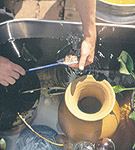 Step 5
Step 5
5. Add fauna. Add tadpoles, goldfish, a catfish, and/or snails. The tadpoles clean up after the fish, the fish eat bugs, the catfish eats algae off the bottom, and the snails clean up the rest. If the balance is right, maintenance is simple. Experts suggest you add one snail and one fish per square foot of water surface.
6. Keep it growing.
Copyright © www.100flowers.win Botanic Garden All Rights Reserved